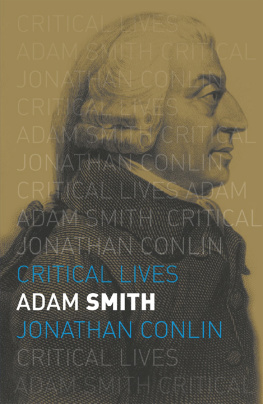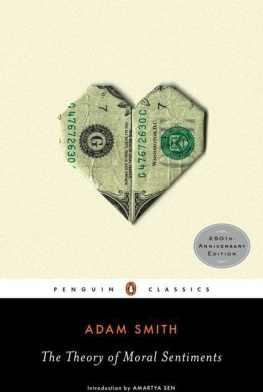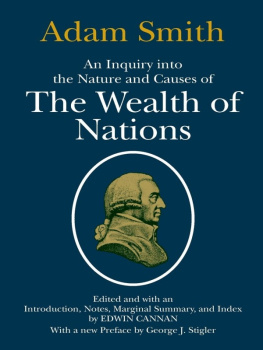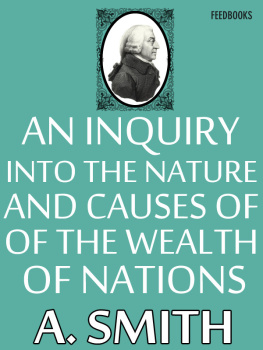Adam Smith

Titles in the series Critical Lives present the work of leading cultural figures of the modern period. Each book explores the life of the artist, writer, philosopher or architect in question and relates it to their major works.
In the same series
Antonin Artaud David A. Shafer
Roland Barthes Andy Stafford
Georges Bataille Stuart Kendall
Charles Baudelaire Rosemary Lloyd
Simone de Beauvoir Ursula Tidd
Samuel Beckett Andrew Gibson
Walter Benjamin Esther Leslie
John Berger Andy Merrifield
Jorge Luis Borges Jason Wilson
Constantin Brancusi Sanda Miller
Bertolt Brecht Philip Glahn
Charles Bukowski David Stephen Calonne
William S. Burroughs Phil Baker
John Cage Rob Haskins
Albert Camus Edward J. Hughes
Fidel Castro Nick Caistor
Paul Czanne Jon Kear
Coco Chanel Linda Simon
Noam Chomsky Wolfgang B. Sperlich
Jean Cocteau James S. Williams
Salvador Dal Mary Ann Caws
Guy Debord Andy Merrifield
Claude Debussy David J. Code
Fyodor Dostoevsky Robert Bird
Marcel Duchamp Caroline Cros
Sergei Eisenstein Mike OMahony
Michel Foucault David Macey
Mahatma Gandhi Douglas Allen
Jean Genet Stephen Barber
Allen Ginsberg Steve Finbow
Ernest Hemingway Verna Kale
Derek Jarman Michael Charlesworth
Alfred Jarry Jill Fell
James Joyce Andrew Gibson
Carl Jung Paul Bishop
Franz Kafka Sander L. Gilman
Frida Kahlo Gannit Ankori
Yves Klein Nuit Banai
Akira Kurosawa Peter Wild
Lenin Lars T. Lih
Stphane Mallarm Roger Pearson
Gabriel Garca Mrquez Stephen M. Hart
Karl Marx Paul Thomas
Henry Miller David Stephen Calonne
Yukio Mishima Damian Flanagan
Eadweard Muybridge Marta Braun
Vladimir Nabokov Barbara Wyllie
Pablo Neruda Dominic Moran
Georgia OKeeffe Nancy J. Scott
Octavio Paz Nick Caistor
Pablo Picasso Mary Ann Caws
Edgar Allan Poe Kevin J. Hayes
Ezra Pound Alec Marsh
Marcel Proust Adam Watt
John Ruskin Andrew Ballantyne
Jean-Paul Sartre Andrew Leak
Erik Satie Mary E. Davis
Arthur Schopenhauer Peter B. Lewis
Adam Smith Jonathan Conlin
Susan Sontag Jerome Boyd Maunsell
Gertrude Stein Lucy Daniel
Igor Stravinsky Jonathan Cross
Leon Trotsky Paul Le Blanc
Richard Wagner Raymond Furness
Simone Weil Palle Yourgrau
Ludwig Wittgenstein Edward Kanterian
Frank Lloyd Wright Robert McCarter
Adam Smith
Jonathan Conlin
REAKTION BOOKS
For Pat
Published by Reaktion Books Ltd
Unit 32, Waterside
4448, Wharf Road
London N1 7UX, UK
www.reaktionbooks.co.uk
First published 2016
Copyright Jonathan Conlin 2016
All rights reserved
No part of this publication may be reproduced, stored in a retrieval system, or transmitted, in any form or by any means, electronic, mechanical, photocopying, recording or otherwise, without the prior permission of the publishers
Page references in the Photo Acknowledgements
match the printed edition of this book.
Printed and bound in Great Britain by Bell & Bain, Glasgow
A catalogue record for this book is available from the British Library
eISBN: 9781780236001
Contents
Note on the Text
All quotations, with original spellings, are taken from The Glasgow Edition of the Works and Correspondence of Adam Smith, edited by R. H. Campbell and A. S. Skinner, published between 1975 and 1987 by Oxford University Press, and also available in inexpensive paperback form from Liberty Fund Press.
C | Correspondence of Adam Smith, ed. E. C. Mossner and I. S. Ross |
EPS | Essays on Philosophical Subjects, ed. W.P.D. Wightman, J. C. Bryce and I. S. Ross |
LJ | Lectures on Jurisprudence, ed. R. L. Meek, D. D. Raphael and P. G. Stein |
LRBL | Lectures on Rhetoric and Belles Lettres, ed. J. C. Bryce |
TMS | The Theory of Moral Sentiments, ed. A. L. Macfie and D. D. Raphael |
WN | An Inquiry into the Nature and Causes of the Wealth of Nations, ed. William B. Todd |

Introduction
The eighteenth-century Scottish thinker Adam Smith (17231790) is considered to be the founding father of free market economics. Unlike many twentieth- and twenty-first-century practitioners of economics, however, Adam Smith preferred telling stories to writing equations; homespun tales about routine interactions and everyday objects, about things of a very frivolous nature that nonetheless revealed something important about the nature of man (TMS, 17). Smiths surviving works originated as lectures written for delivery to undergraduates at the University of Glasgow. Although the Scottish education system was one of the finest around in the eighteenth-century world, were we able to travel back and sit in on one of Professor Smiths classes we would immediately be struck by how young the audience was. Smith was lecturing teenagers aged between fourteen to sixteen (between 7:30 am and 8:30 am, no less), which explains some, but not all, of his fondness for telling stories.
Smiths eighteenth-century prose can make reading his work something of a challenge. He may have been lecturing to teenagers, but it can feel as if Smith is speaking a dead language. This book will suggest that this problem lies as much in our failure to listen correctly as to any shift in vocabulary or any weaknesses in Smiths thought. Until fairly recently the only people listening to Smith were economists, and some philosophers. Even then, each expected Smith to speak their language and became inattentive, frustrated or bored when Smith failed to do so. As with many great thinkers of the past, were he to return to life Smith would probably be surprised by what his self-proclaimed followers have done in his name. He would be frustrated by the tendency to draw a line between his study of political economy, that is, of the best means of promoting opulence in a nation, and his moral philosophy, his attempt to advance a set of moral principles grounded in human nature. One of the teenagers sitting in Professor Smiths class in 1766 transcribed the following pithy summary, which presents these investigations as equally necessary and interlocking:

William Hogarth, Scholars at a Lecture, 1736, etching and engraving. Adam Smiths students presumably paid more attention than the students depicted here.












